Advances in
eISSN: 2373-6402


Research Article Volume 8 Issue 4
1Soil Science Division, Nepal Agricultural Research Council, Nepal
2,Department of soil science and Agri-engineering, Agriculture and Forestry University, Nepal
Correspondence: Roshan Babu Ojha, Soil Science Division, Nepal Agricultural Research Council, Nepal
Received: August 13, 2017 | Published: July 23, 2018
Citation: Ojha RB, Basyal B, Khanal, et al. Nitrogen-Sulphur use economics in rapeseed productivity at Rampur, Chitwan, Nepal. Adv Plants Agric Res. 2018;8(4):312-316 DOI: 10.15406/apar.2018.08.00332
Nitrogen and sulfur are one the most yield limiting factors for rapeseed production in the sandy loamy soil (Inceptisols) of the Chitwan, Nepal. A field experiment was conducted to study the effect of different rate of nitrogen and sulfur application on selected soil parameters, yield and yield components of the rapeseed. The experiment consisted of twelve treatments with different combinations of nitrogen and sulfur and was laid out in the factorial treatments arranged in Randomized Complete Block Design (RCBD) with three replications. Factors included three levels of nitrogen (0, 60, and 100 kg N ha-1) and four levels of sulfur (0, 10, 25, and 50 kg S ha-1) respectively. The highest yield was obtained from 100 kg N ha-1 as compared to the control (N0). Seed yield and seed oil content of the rapeseed significantly increased with the sulfur level. Application of 25 kg S ha-1 produced the highest yield as compared to the control which had the lowest yield (0.178tha-1). Similarly, 10 kg S ha-1 produced the highest oil content (38.37%) compared to the control (36.41%). The interaction effect of nitrogen and sulfur at the rate of 100 kg N ha-1 and 10 kg S ha-1 produced significantly highest yield as compared to control. The seed oil content of the rapeseed was also significantly influenced by the combined application of nitrogen and sulfur. The highest oil content (39.53%) was observed from the plot with 60 kg N ha-1 and 50 kg S ha-1 which was at par with 100 kg N ha-1 and 10 kg S ha-1 compared to the control plot which had the minimum oil content in the seed (35.57%). Sulfur level affect significantly the soil total nitrogen and the highest of which was observed from the treatment 25 kg S ha-1 followed by 10 kg S ha-1. Addition of nitrogen was found to increase the plant nitrogen content though it was not significantly different. The economic optimum rate for nitrogen and sulfur was found to be 182 kg N ha-1 and 30 kg S ha-1 respectively. In our finding, Sulphur is not limiting for rapeseed production compared to Nitrogen. Balanced replenishment of Sulphur by crop uptake is sufficient to obtain rapeseed optimum productivity. Nitrogen dose can be tripled (180 kg N ha-1) to that of recommended dose (60 kg N ha-1) for maximizing rapeseed economic production.
Keywords: nitrogen, nutrient use economics, oil content, rapeseed, sulfur
N and S are the most limiting factor for rapeseed production. Apart from various factor, declining level of N and S is evident in decreasing level of the rapeseed productivity. Available soil-N supplies are generally inadequate for optimum crop production. It was reported that the crop production appears to be limited by N, K and Sin Chitwan condition.1 The productivity of rapeseed has been declining for last many years as reported from various parts of the country.2 Depletion of the organic matter in soil, use of single graded fertilizer in low amount, deficiency of nutrients (especially N, S, and B) have been recognized as the major cause for the declining rapeseed in the Chitwan valley.3 Interaction effect of the sulphur and nitrogen are directly related to the alteration of physiological and biochemical responses of crops, and so it should be studied in depth.4 N could be a significant strategy for improvement of growth and productivity of rapeseed and mustard.5 The study of the nitrogen and sulphur interaction is so required to help understand nutritional behavior of sulphur in relation to nitrogen nutrients and provide guidelines for evaluating the balanced fertilizer combination in order to optimize yield and quality of crops.6,7 Oilseed crops are the third most important crops of Nepal after cereals and legumes in both area and production. Rapeseed occupies 80% of the total area among the oilseed crops8 which indicates the wide acceptance of the rapeseed oil by Nepalese people for cooking purpose. The productivity of rapeseed has been declining for last many years as reported from various parts of the country.2 Nepal, which was oilseed exporting country till early seventies, has turned into edible oil importing country (NORP, 1998/1999). So, this study aimed to evaluate rapeseed yield as influenced by N-S interaction and to find economic nutrient dose for farmers of inner-Terai regions for better profitability.
A field research was conducted at agronomy farm of Agriculture and Forestry University, Chitwan, Nepal with two factors, Nitrogen with three levels (0, 60, 100 kg N ha-1) and Sulphur with four levels (0, 10, 25, 50 kg S ha-1) arranged in factorial randomized complete block design. Twelve treatments combination (N0S0, N0S10, N0S25, N0S50, N60S0, N60S10, N60S25, N60S50, N100S0, N100S10, N100S25, and N100S50) were replicated thrice with individual plot size 4x2.1m. Preeti variety of rapeseed was selected as it is the recommended variety for the inner-Terai region. Various soil parameters and plant parameters like oil content and yield were observed. Sampling of soil and plant was done after rapeseed harvesting and analyzed with standard lab procedure in Aastha Scientific Technology Lab, Kathmandu. Statistical analysis was done with the help of Gen Stat version 4. Data were subjected to normality test and linearity test. Normal data are used for two-way analysis of ANOVA. Means were separated at 5% level of significance with Duncan’s multiple range test.
Plant nitrogen and sulphur content and their uptake
The main effect of sulphur and nitrogen was not found significant on the plant nitrogen content of rapeseed. Similarly, the main effect of nitrogen was not found significant on plant sulphur content of rapeseed but there found significant effect of sulphur application on plant sulphur content of rapeseed. Application of 10 t S ha-1 provided the highest plant sulphur content of rapeseed which is significantly different with other doses of sulphur (Table 1). However, the interaction of sulphur and nitrogen application gave the significant result on plant nitrogen content. The interaction of 60 kg N ha-1 and 50 kg S ha-1 increased the highest plant nitrogen content which is at par with 100 kg N ha-1 and 50 kg S ha-1 application (Figure 1) but N-S interaction didn’t significantly increase the plant sulphur content. The main effect of nitrogen application has significant effect on plant uptake of nitrogen by rapeseed plant. The highest nitrogen uptake (12.46 kg ha-1) was obtained from 100 kg N ha-1 which is significantly different with application of 60 kg N ha-1 and control. Similarly, sulphur application has also significant effect on nitrogen uptake by the plant. The highest nitrogen uptake (10.87 kg ha-1) was obtained from 25 kg S ha-1 however, it was not significantly differed with nitrogen uptake obtained from application of 50 kg and 10 kg S ha-1 (Table 2). Similarly, the main effect of nitrogen has significant effect on sulphur uptake by rapeseed. The highest sulphur uptake (1.99 kg ha-1) was obtained from 100 kg N ha-1 which is significantly different with 60 kg and 0 kg N ha-1. Similarly, sulphur application has also significant effect on plant uptake of sulphur by rapeseed. The highest sulphur uptake (1.7 kg ha-1) was obtained from 10 kg S ha-1, which was statistically similar with sulphur uptake obtained from 50 kg S ha-1 and 25 kg S ha-1 and significantly different than control (Table 2). Nitrogen and sulphur interaction has not significant effect on nitrogen and sulphur uptake by rapeseed (data not shown)
Yield and oil content
The main effect of nitrogen and sulphur application was found highly significant on the yield of rapeseed. The highest yield of rapeseed was found to be 0.59 t ha-1 from N100 which was significantly different than other nitrogen doses. Similarly, the highest yield was found to be 0.52 tha-1 from application of 25 kg S ha-1 which was found statistically similar with 50 kg and 10 kg S ha-1 having yield as 0.50 t ha-1 and 0.45 tha-1 respectively (Table 3). The interaction effect of nitrogen and sulphur was found highly significant on grain yield of rapeseed. The highest yield was obtained as 0.7 tha-1 from N100S10 which was statistically similar with N100S50 and significantly different with rest treatments (Figure 2). The main effect of nitrogen was found highly significant in biological yield of rapeseed. The highest biological yield of rapeseed was found to be 2.83 tha-1 obtained from N100 which was significantly different than other nitrogen doses. Similarly, the main effect of sulphur on biological yield of rapeseed was found highly significantly different. The highest biological yield of the rapeseed was found to be 2.59 tha-1 obtained from S25 which is significantly higher than S10 and S50 (Table 3). The interaction effect of nitrogen and sulphur was not found significant in biological yield of rapeseed (data not shown). The oil content of rapeseed was not found significantly increases with different dose of nitrogen (Table 3) but oil content increased significantly with the application of sulphur. The highest oil content was 38.37% from 10kg S ha-1 which was statistically similar with 36.41% and 37.28% obtained from 25kg S ha-1 and 50kg S ha-1 respectively (Table 3). The interaction effect of nitrogen and sulphur was significantly affected by N60S50 gave maximum oil content similar with N100S10 (Figure 3). The N-S interaction in producing grain yield and oil content was found significant effect for rapeseed productivity.
Economic optimum nutrient response
The effect of nitrogen in the BC ratio was found highly significantly different. The highest BC ratio was found to be 1.14 from 100 kg N ha-1 and the lowest BC ratio was 0.56 obtained from 0 kg N ha-1. Similarly, the effect of sulphur was found highly significantly different on BC ratio of rapeseed. The highest BC ratio (1.05) was observed from 25 kg S ha-1 and the lowest BC ratio was 0.62 obtained from 0 kg S ha-1. The interaction effect of nitrogen and sulphur was not significantly different in BC ratio of rapeseed. However, combined application of N100S10 produced the highest BC ratio (1.39) and the lowest BC ratio was 0.48 obtained from N0S10 (Table 4).
Response curve of the nitrogen
The quadratic function for yield (Y) on the applied level of nutrients (x) was obtained as Y = -0.0108x2 + 4.4833x + 250 for nitrogen with perfect coefficient of determination and Y = -0.2372x2 + 16.114x + 283.81 for sulphur with 0.96 coefficient of determination. Per unit output of sulphur was relatively higher than per unit output of nitrogen. Addition of sulphur (intercept value 16.11) showed better response than addition of nitrogen (intercept value 4.483) in sulphur productivity. But, the response of sulphur cannot be obtained beyond 34 kg of applied sulphur but response of nitrogen can be obtained up to 208 kg of applied nitrogen. However, the requirement of nitrogen is relatively higher than sulphur for rapeseed productivity (Figures 4 & 5).
Physical maxima and economic optima of fertilizer use
Physical maximum dose of any nutrient occurs at any point where,
(First derivative of response curve equals to zero)
Y = -0.2372S2 + 16.114S + 283.81
Differentiating the equation with respect to S on both sides,
=2(-0.2372S2-1 + 16.114S1-1 + 0)/ds
= 16.114-0.4744S
Equating the differentiating product with 0,
16.114- 0.4744S = 0
S = 16.114 / 0.4744
S = 33.97 kgha-1
Economic optimum dose occurs at point where, first derivative of response curve equals to unit price ratio of applied nutrients (Pn) to produce (Pp)
i.e.
202.671/100 = 16.114- 0.4744S
2.0267 = 16.114- 0.4744S
S = (16.114 – 2.0267) / 0.4744
S = 14.0873 / 0.4744
S = 29.69 kg ha-1
Thus, the economic optimum dose of sulphur was 29.69 kg S ha-1.
Application of different level of nitrogen significantly influenced seed yield of rapeseed. Similar was reported by Karamzadehet. al.,9; Ozturk10 ; Cheemaet al.,11 The application of nitrogen increased the yields of seed and oil, principally through increased production of seeds by a larger number of pods.12 Application of different level of sulphur significantly increased the seed yield of rapeseed. The grain yield varied between 0.27tha-1 from application of 0 kg S ha-1 to 0.52 tha-1 from application of 25 kg S ha-1. This finding was also supported by Sharifi.13 Similar result was also reported by Khalid et al. (2009) who stated that application of 40 kg S ha-1 produced the highest seed yield. Seed yield of rapeseed was significantly influenced by the interaction effect of nitrogen and sulphur. Similar findings were also reported by Cheemaet & Kumar et al.14,15 The highest seed yield was achieved from the combination of N100S10 which was also at par with N100S50. And the lowest yield was achieved from the treatment N0S0. Sulphur also helps in assimilation of nitrogen thereby producing more nitrogenous metabolites and photo synthates, which help to increase the total dry matter resulting the more yield. The increase in yield with the various combinations of nitrogen and sulphur may be due to the positive effect of those combinations on major yield attributing characters viz: number of siliqua per plant, seed per siliqua and 1000 seed weight of rapeseed.
Effect of nitrogen in oil content of rapeseed was not found significant. It was also reported that application of different nitrogen level did not affect the oil content of rapeseed.16 However, maximum oil content was achieved from application of 100 kg ha-1nitrogen and the lowest oil content was achieved from 0 kg ha-1 nitrogen. These positive findings are in line with Mansoori17 who stated that with increasing nitrogen levels from 0 kg ha-1 to 80 kg ha-1, the seed oil percentage increased from 34.91% to 39.83%. Cheema et al.,14 who stated that maximum oil content was obtained from 120 kg N and 125 kg S and the minimum was obtained from 60 kg N and 0 kg S. These findings are also supported by Ahmad et al.,18 ; Kumar et al.,15 The effect of the soil applied sulphur was found significant on the soil total nitrogen in rapeseed field. This finding was in line with Mirzashahi et al.,19 who stated that soil nitrogen content increased with application of sulphur compared to control. Soil available sulphur increases with the increasing level of sulphur from 0 kg ha-1 to 25 kg ha-1. Similar positive findings were also supported by Chattopaddhyay & Ghosh.20 The highest soil available sulphur was achieved from S25 (0.262%) and the lowest was achieved from S0 (0.240%). This might be due to use of elemental sulphur as the source of sulphur. Friesen21 reported the leaching loss of applied sulphur up to 20% from elemental sulphur compared to 50% from ammonium sulfate.
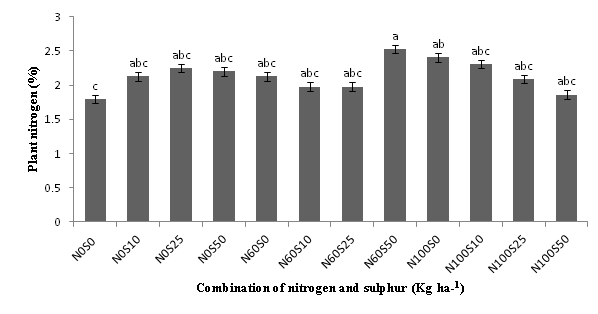
Figure 1 Effect of nitrogen and sulphur interaction in plant nitrogen content of the rapeseed at AFU, Rampur Chitwan.
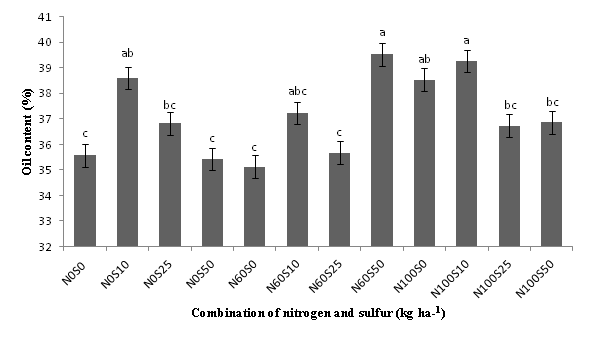
Figure 2 Effect of nitrogen and sulphur interaction in oil content of the rapeseed at AFU, Rampur, Chitwan, Nepal.
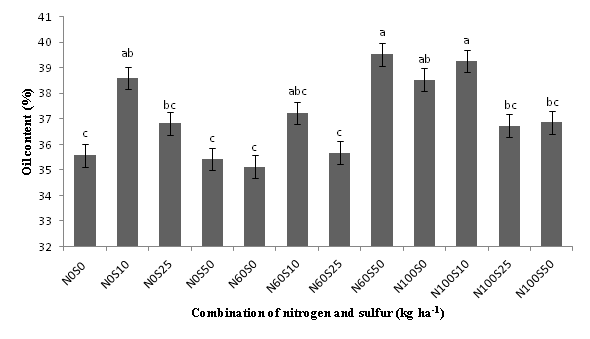
Figure 3 Effect of nitrogen and sulphur interaction in oil content of the rapeseed at AFU, Rampur, Chitwan, Nepal.
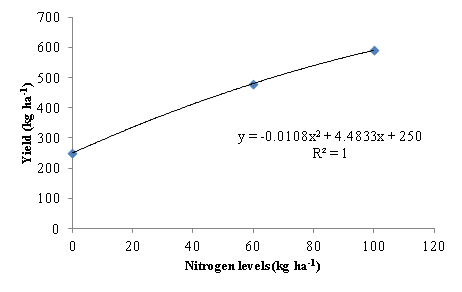
Figure 4 Response of rapeseed to different level of nitrogen (kgha-1) grown at AFU, Rampur, Chitwan.
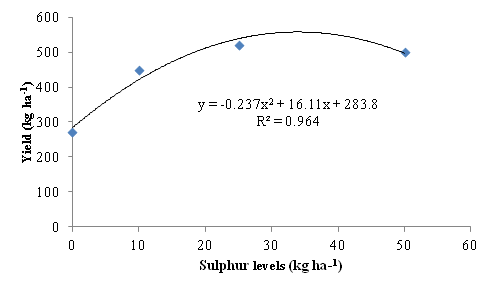
Figure 5 Response of rapeseed to different level of sulphur (kg ha-1) grown at AFU, Rampur, Chitwan.
Treatments |
Plant nitrogen (%) |
Plant sulphur (%) |
N0 |
2.096 |
0.311 |
N60 |
2.154 |
0.308 |
N100 |
2.167 |
0.349 |
LSD(P=0.05) |
NS |
NS |
SEm (±) |
0.0832 |
0.0188 |
S0 |
2.11 |
0.301b |
S10 |
2.139 |
0.382a |
S25 |
2.108 |
0.298b |
S50 |
2.199 |
0.31b |
LSD(P=0.05) |
NS |
0.0638* |
SEm (±) |
0.0961 |
0.0218 |
CV (%) |
13.5 |
20.2 |
Grand mean |
2.139 |
0.323 |
Table 1 Effect of nitrogen and sulphur on N and S content of rapeseed at Rampur, Chitwan, 2015/2016
Means followed by the same letter in the column and row are not significantly different by DMRT (P<0.05),* Significant at 5% level and ** significant at 1% level
Treatments |
Nitrogen uptake (kg ha-1) |
Sulphur uptake (kg ha-1) |
N0 |
5.31c |
0.77c |
N60 |
10.00b |
1.39b |
N100 |
12.46a |
1.99a |
LSD(P=0.05) |
2.33** |
0.33** |
SEm (±) |
0.79 |
0.11 |
S0 |
5.62b |
0.79b |
S10 |
9.72a |
1.70a |
S25 |
10.87a |
1.52a |
S50 |
10.82a |
1.54a |
LSD(P=0.05) |
2.69** |
0.38** |
SEm (±) |
0.92 |
0.13 |
CV (%) |
29.7 |
28.3 |
Grand mean |
9.26 |
1.39 |
Table 2 Effect of nitrogen and sulphur interaction on N and S uptake of rapeseed at Rampur, Chitwan 2015/2016
Means followed by the same letter in the column and row are not significantly different by DMRT (P<0.05),* Significant at 5% level and ** significant at 1% level
Treatments |
Grain Yield (t ha-1) |
Biological yield (t ha-1) |
Oil content (%) |
N0 |
0.25c |
1.450c |
36.61 |
N60 |
0.48b |
2.308b |
36.89 |
N100 |
0.59a |
2.833a |
37.85 |
LSD(P=0.05) |
0.078** |
0.321** |
NS |
SEm (±) |
0.026 |
0.109 |
|
S0 |
0.27b |
1.600c |
0.361 |
S10 |
0.45a |
2.133b |
36.41b |
S25 |
0.52a |
2.589a |
38.37a |
S50 |
0.50a |
2.467ab |
36.41b |
LSD(P=0.05) |
0.09** |
0.371** |
37.28b |
SEm (±) |
0.03 |
0.127 |
1.224* |
CV (%) |
21.2 |
17.3 |
3.4 |
Grand Mean |
0.433 |
2.197 |
37.12 |
Table 3 Effect of nitrogen and sulphur on yield, biological yield and Oil Content of rapeseed at Rampur, Chitwan, 2015/2016
Treatments |
BC ratio |
|
|
|
|
N0 |
N60 |
N100 |
Mean |
S0 |
0.5 |
0.67 |
0.67 |
0.62b |
S10 |
0.48 |
0.96 |
1.39 |
0.94a |
S25 |
0.76 |
1.01 |
1.27 |
1.05a |
S50 |
0.5 |
1.03 |
1.24 |
0.92a |
Mean |
0.56c |
0.94b |
1.14a |
0.88 |
LSD(P=0.05) |
NS |
N: 0.15** |
S: 0.17** |
|
SEm (±) |
0.103 |
|
0.052 |
0.059 |
CV (%) |
20.3 |
|
|
|
Table 4 Effect of nitrogen and sulphur interaction on BC ratio of rapeseed at Rampur, Chitwan, 2015/2016
Means followed by the same letter in the column and row are not significantly different by DMRT (P<0.05), * Significant at 5% level and ** significant at 1% level
Application of 100 kg N ha-1 produced the highest yield of rapeseed with positive influence in plant nitrogen content and nitrogen uptake from soil. The highest oil content was also obtained from 100 kg N ha-1 though the effect was not significant. Similarly, application of 25 kg S ha-1 produced the highest yield however; it was not significantly differed with yield from 10 kg and 50 kg S ha-1 which is helpful to increase plant sulphur content and sulphur uptake from soil. And 10 kg S ha-1 produced the highest oil content. Combined application of 100 kg Nha-1 and 10 kg S ha-1 produced the highest yield (0.70 t ha-1) which was also similar with the combination of 100 kg N ha-1 and 50 kg S ha-1. In case of oil content, the highest was produced by N60S50 level however; it was not significantly differed with combination of N100S10, which have the highest yield. The response level of sulphur seems more than nitrogen during interaction and the highest economic return was obtained from 182 kg N ha-1 and 30 kg S ha-1. Application of elemental sulphur as the source of sulphur requires microbial oxidation to become available to the plant in sulfate (SO42-) form. Response of sulphur fertilizer to the plant was delayed. Moreover, elemental sulphur due to its acidifying properties affects the availability of the other nutrients reducing the soil pH. So the further research using the different source of the sulphur is recommended.
Authors would like to express their deep gratitude to Nepal Agriculture Research Development Fund (NARDF) for funding. We would also like to thank Oilseed research program for providing seed materials. We acknowledge the help of Mr. Raju Lamichhane and the entire soil science department of Agriculture and Forestry University without which this work is not possible.
The author declares there is no conflict of interest.

©2018 Ojha, et al. This is an open access article distributed under the terms of the, which permits unrestricted use, distribution, and build upon your work non-commercially.